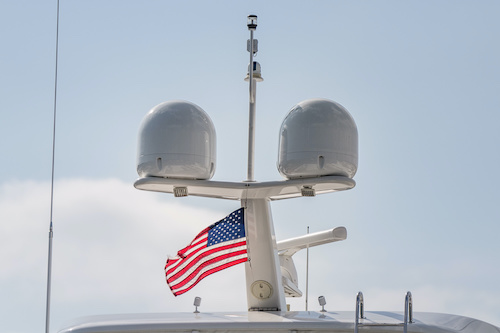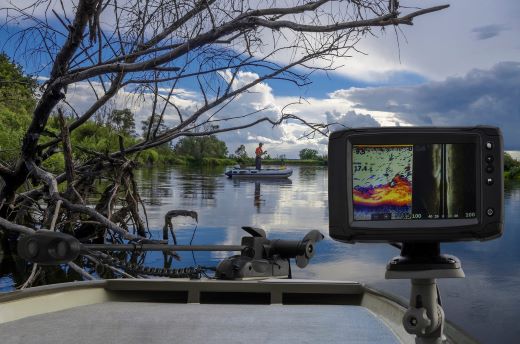Whether you're an experienced boater or a novice, a boat radar is essential for safe adventures on the water. Leverage one to simplify navigation, detect weather events, avoid collisions, and locate boats and other objects during emergencies.
In the past, marine radar units were often difficult to read and tune. Fortunately, they've advanced significantly over the past few decades, making life easier for both new and experienced boaters.
Thanks to updated software by manufacturers, automatic tuning is now the norm. You no longer have to go through the hassle of ongoing tuning to account for different conditions. Just like modern fish finders, today's advanced algorithms mean that "Auto" mode can do a better job of tuning the picture than a human can 99 percent of the time.
Once your boat radar is set up and integrated with the electronics suite (a job often best left to the pros), and you press the power button, your biggest challenge will be interpreting the screen. The learning curve is no big deal.
With a bit of knowledge, practice, and dedication, you can make the most out of your boat radar and navigate safely, even when conditions are poor. Let's take a closer look at how to use a boat radar as well as recommendations for quality radars.
How Does a Marine Radar Work?
Boat radar systems emit high-frequency radio waves and then listen for any return signals that get bounced back. When that signal bounces off a boat, channel marker, or other solid object, some units calculate how long the process took to determine the distance to the object. In contrast, some others make the calculation using the difference in the return's frequency.
But radar waves aren't just bounced back by boats and channel markers. Rain, flocks of birds, or even rough seas can reflect enough radar waves to confuse the unit—and the unit's user. That used to mean that interpreting the screen could be extremely difficult. But again, today it's much easier than it once was.
The vast majority of today's units are equipped with color-coding targets that appear on the multifunction display's LCD screen (or a dedicated radar screen) according to the strength of the return they provide.
Similar to a fish finder, hotter colors, such as oranges and reds, are used to indicate stronger returns. Lighter colors, such as greens and blues, commonly indicate weaker returns. So large solid items, like land, become much easier to differentiate from softer items, such as a rainstorm.
8 Tips for Using a Boat Radar
Are you wondering how to use boat radar? Here are eight tips to steer you toward the right direction (no pun intended).
1. Turn On the Radar
First and foremost, turn on the radar. If you have an older model, it may take between 30 and 60 seconds to get up and running. A newer model, on the other hand, will likely start immediately.
2. Adjust the Range
Once your radar has completed the warmup period and is ready to go, switch from Standby to Transmit mode. Then, it's time to adjust the range, which will allow you to set the distance at which your radar will show its targets. Choose a range that's suitable for the area you're in.
Pointers for Adjusting the Range
- Don't Assume the Range Needs to Be As Far as Possible
Keep in mind that setting the range is often where mistakes occur. This is because most people's first impulse is to set it as far as possible. But if you have a 24-mile radar, even when you're 24 or more miles from shore, you'll rarely want to range it out that far.
Trying to represent such vast distances on a 12- or 16-inch LCD screen, all but the most massive targets become tiny dots that you might not ever see, and if there are many targets, the screen will be a smattering of small dots.
- Understand the Value in Shorter Ranges
It will be much, much easier to determine what you're looking at if you drop down the range to just a mile or two, which is the area you should be most concerned with anyway, since collision avoidance is the number-one job radar does. And when you need to identify specific structures, such as inlets or piers, ranging further makes them much easier to locate.
Those long-range views can be helpful when you're trying to get a return from far-off land masses or track a thunderstorm. But otherwise, shorter ranges are usually much more helpful. When you need to gather information on all of the above, use a split-screen mode with different ranges displayed, or range in and out in turn.
3. Learn the Display
Next, familiarize yourself with the various display modes so you can utilize them effectively and navigate safely. Here's a closer look at several of the most common modes:
- Head-Up Mode: Head-up mode places the boat's heading at the top of the screen.
- North-Up Mode: North-up mode aligns with the north direction.
- Course-Up Mode: Course-up mode reveals the desired course of the boat.
- Relative Motion Mode: In relative motion mode, your boat is stationary, and other targets move across it.
- True Motion Mode: This mode stabilizes the radar, ensuring its orientation remains constant.
- Harbor Mode: Harbor mode brings more definition to surrounding boats, making it ideal for crowded areas.
4. Calibrate to Ensure Clarity
Then, make any necessary modifications to ensure everything is clear. Gain is essentially a volume knob. Ideally, you'd turn it up and down until all you can hear is echoes.
Sea clutter, or STC, filters out the "halo" from waves and should be higher in rough waters and lower when conditions are calm. Rain clutter or FTC can reduce raindrop disruption and should be lowered unless it rains.
5. Read with Accuracy
It's essential to interpret the boat radar correctly so you have a good idea of common threats. Landmasses and shorelines, for example, look like wide echoes that stay in place and look like a single, continuous line.
Other boats appear as blips that move. If you notice a blip getting closer to you, it's in the course of a collision, and you need to proceed with caution. Markers and buoys are usually tiny, stationary blips that may flicker in and out due to waves.
6. Master Range Scale Rings
Range scale rings are circles that help you gauge the distance between your boat and various targets. While some radars denote rings automatically, others require you to do some math. Additionally, some radars are equipped with Variable Range Markers (VRMs), allowing you to measure the distance to a specific target accurately.
Long range is ideal for keeping tabs on weather conditions and larger vessels. Medium-range radar can be particularly useful near shore to monitor fishing boats and ferries, for example. Short range is a must when it's foggy or dark outside, or you'd like to avoid markers. To stay informed of near and far hazards, it's a good switch between these ranges.
7. Use Situational Awareness
General situational awareness also plays a role in interpreting what you see on the radar screen. This is because different conditions can have different effects on what you're looking at.
Sea state, for example, can cause your boat to pitch in the waves. As the bow goes up on a large wave, the radar's transmission may temporarily pass right over a target, and it will disappear from your radar screen for a second or two at a time.
Another example is heavy rain, which can blanket a portion of your screen and hide the returns of other targets.
Whenever you're captaining your boat, you should maintain a high level of situational awareness, which includes interpreting the radar as well.
8. Practice on Nice Days
To feel more confident with your boat's radar, use it on a calm day when the waters are clear and landmarks are visible. Compare the image it produces with your views, as well as your electronic or paper chart. Be sure to switch ranges and keep tabs on moving targets. By practicing in clear conditions, you'll feel more confident in foggy or dark conditions.
Basic Boat Electronics for Beginners
5 Boat Radars to Explore
If you're in the market for boat radar systems, there are countless options at your disposal. Here are several of our top picks to help you with your search.
1. Garmin GMR Fantom™ 18x/24x Dome Radar
The intuitive Garmin GMR Fantom™ 18x/24x Dome radar uses MotionScope technology to highlight targets in color as they move toward or away from you. There's also a power save mode that allows you to choose between more or less power, enabling you to conserve it properly. Additionally, the timed transmit mode makes it easy to define transit times in seconds, resulting in further power savings.
2. Humminbird CHIRP Radar
With the Humminbird CHIRP radar, you'll enjoy CHIRP Pulse Compression, which generates exceptional images on long and short ranges, improving your situational awareness. Additionally, it provides unparalleled definition for tracking weather and other vessels. This radar is only 12.3 lbs and starts in seconds, so you don't have to worry about a long warmup.
3. Si-Tex Marine Electronics MDC-900 SERIES 8.5" Radar
The Si-Tex Marine Electronics MDC-900 SERIES 8.5" radar features a true trail function that makes it easy to distinguish stationary objects from moving ones. The dual range radar allows you to view long and short-range targets at once. This radar is also compatible with a CCD camera, allowing you to monitor both above and below deck.
4. Simrad HALO Open Array Radar
Advertised as Simrad's most powerful boat radar systems, the Simrad HALO Open Array radar employs ZoneTrack technology, which detects and tracks targets in designated areas. AutoTrack prioritizes the targets on your behalf so you don't have to worry about it. There are also multiple preset user modes, including Harbour, Offshore, Weather, and Bird mode.
5. B&G HALO24 Radar
Thanks to its pulse compression technology with beam sharpening, the lightweight B&G HALO24 radar provides a complete 360-degree view of the sea. Its VelocityTrack Doppler system detects moving objects, and a lightning-fast refresh rate ensures you receive updates in real-time. This radar is renowned for its best-in-class weather and target detection capabilities.
So, which radar is right for you? It all comes down to your unique budget, vessel, boating habits, and individual needs. To zero in on the ideal option, look for radars with a range that meets your usual navigation areas. Also, ensure that the radar integrates seamlessly with your current navigation equipment and includes target detection, Doppler tracking, and fast refresh rates, all of which can enhance safety and provide you with greater peace of mind.
Ready to Use Your Own Marine Radar System?
Boat radar systems can be an invaluable tool, and using them has become far simpler than it once was. Even so, it takes most people a season or two to become accustomed to using radar. In this regard, there's no substitute for on-the-water experience. With some practice, you'll be using your boat radar like a pro.


